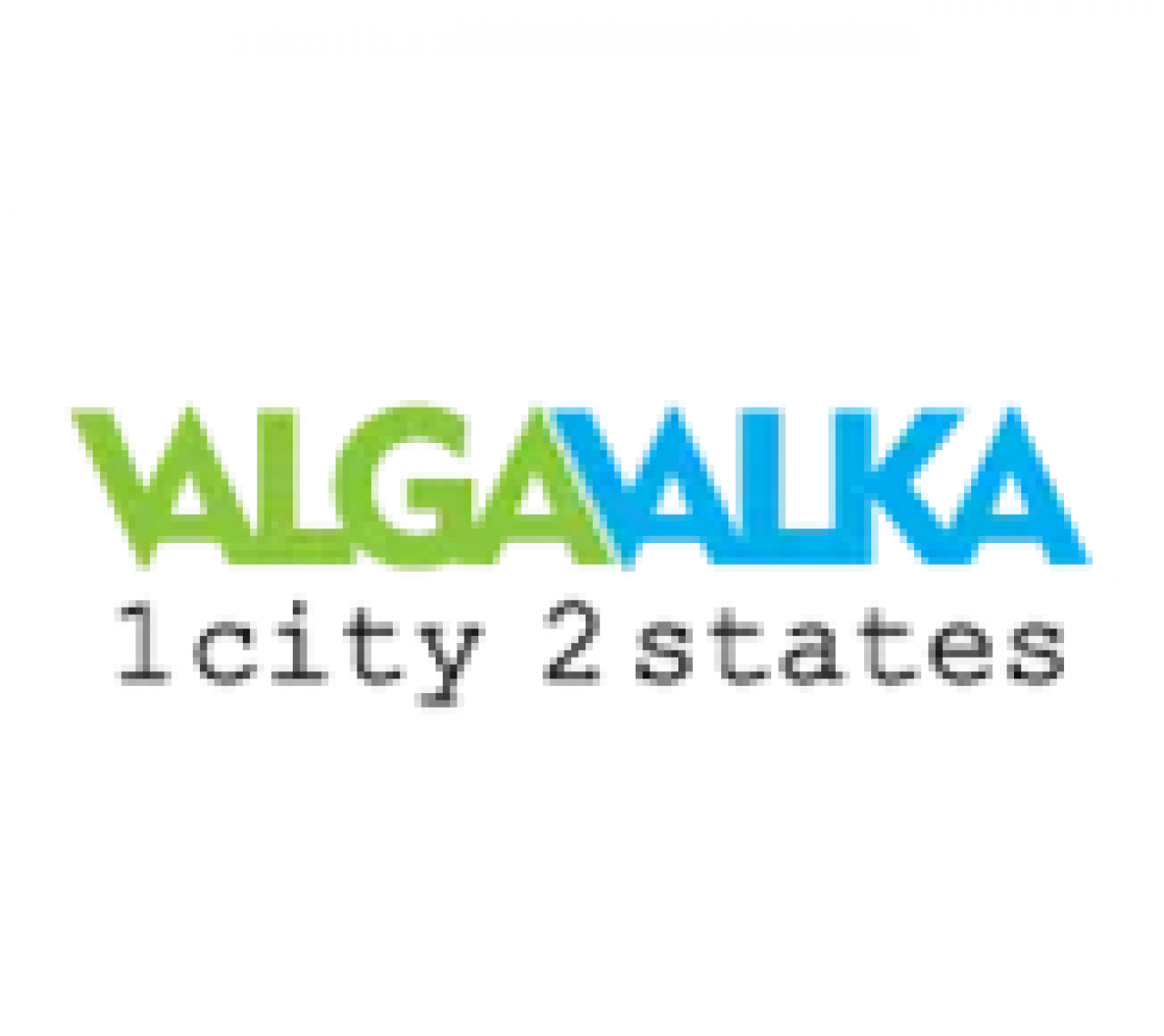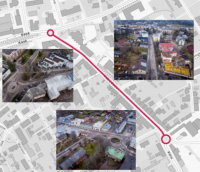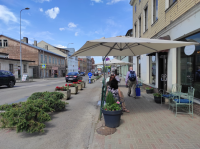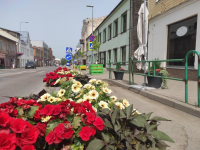
Our network partner Valga is a municipality of 15,500 inhabitants located at the Estonian border to Latvia. Administrative centre of the municipality is Valga town with 12,000 inhabitants. But Valga is more than just a town in Estonia: Valga is one part of a twin city with Latvian Valka where the city just goes on once crossing the border. Valga/Valka share a common history: they were one city until they got separated when Estonia and Latvia gained independence from the Russian Empire in 1918-1920. During the following decades, both towns developed separately neglecting the common structures and culture. Now, since several years, Valga/Valka follow up their new common slogan “1 City, 2 States” and invest to re-establish themselves as one town. The largest project just finished is the creation of a joint town centre connecting Valga and Valka beyond the border once more.
This new town centre forms a major step for Valga to gain back attractiveness to its actual central areas and to re-establish civic pride of its inhabitants towards their town. The necessity to do so strongly relates to Valga’s development in the past decades: starting from its positions as an industrial and military centre after World War II, Valga experienced a rapid decline in population with the fall of the Soviet Union. The town’s population shrank from 18,500 to today’s 12,000 with the closure of industries. The result was a “surplus” of all sorts of buildings – apartments, industrial and administrative ones. Only about 72% of the town territory is in use and Valga is today still a shrinking city with projections forecasting a further decline.
The main problems are that:
- the city is too large for its population. Businesses and services are scattered and there is no attractive central area where people would like to spend their free time, which in turn affects the development of small businesses.
- urban environment, predominantly built during Soviet-era is car-oriented and does not offer opportunities for the different sustainable modes of transport or their convenient cross-use.
- local government has not adapted to the situation where the person and his or her mobility preferences should be at the forefront of the planning process.
To stop the population decline, Valga aims to create and provide an attractive environment to live, work and relax to its citizens. The quality of urban space in the town centre is used as the main tool to counteract unattractive public spaces and ultimately population shrinkage. The idea is to create emotional bonds of locals towards their hometown and boost citizens’ activity. The first two projects to bring the city life back to its historical centre were the construction of a new town square between the oldest and central streets in Valga in 2018 as well as developing the new joint town centre linking Valga and Valka together by 2020. One main challenge remains untackled so far though: the poor public space quality and pedestrian connection between Valga’s railstation and the new Valga/Valka town centre.
The main problematic but at the same time also most promising section of this connection is the Vabaduse street. Here, road design sees large road space with unregulated car parking on-street albeit parking options off-street in backyards are at hand at the same time. The road design is made for passing through and not stopping. Pedestrian space is narrow despite the overall road width. The partially heritage protected houses are in poor state. Shopkeepers located at the street are hardly perceptible for potential clients. A new school on the street adds further traffic to the road which creates road safety challenges for pupils at the same time - partially out of parents dropping their children at school by car.
Thus, the Vabaduse street is at the focus of Valga’s work in Space4People forming the next large step to change public space appearance and use to the benefit of its inhabitants and businesses. The objective is the creation and implementation of a new spatial concept for the Vabaduse Street that meets the needs of all user groups and supports the development of small businesses.

At this point, the novel option to URBACT Action Planning Networks to plan and run pilots for their detailed integrated planning process entered the stage. Since Valga has clearly set the focus of work to the Vabaduse street, employing a pilot in the street offered a unique opportunity to demonstrate how changes could look like. The pilot worked with narrowing the road space to the benefit of pedestrians, greeneries and space for outdoor gastronomy during summer 2021. Its main elements were to:
- experiment with tactical urbanism to simulate permanent changes
- temporary road closure to part of the street
- creating pop-up summer-cafes
- giving space to pedestrians and people to spend time
Amongst others, Valga wanted to analyse, if less space for motorised traffic would create traffic congestions. The pilot interventions were planned with business owners, the Valga URBACT Local Group and other stakeholder present in Vabaduse Street such as the school and the local museum. The pilot reduced road space for motorists from 12 m width to 8,5 m on the Eastern side of the road. It gave more space to a) pedestrians and b) outdoor activities of businesses and gastronomy. This space was cut-off from traffic by placing flowerpots at the edge to road traffic space. Tree boxes and outdoor furniture were placed in the enlarged pedestrian and business area as well as seating for outdoor gastronomy. The flowerpots were put in space first, followed by the outdoor seating furniture and then the tree boxes. The pilot was accompanied by Facebook, an own website as well as online media coverage of radio stations and local newspapers.



Installations and placement of greeneries and furniture were done by the ULG members in Valga including the very core team working for Space4People themselves to the largest part. This offered the opportunity to talk with people concerning the tested new spatial configuration and their reactions to these:
At first hand, reactions were not positive. People thought for example that the changes were already permanent ones. Thanks to the presence of the ULG in the pilot area while creating and adding elements, this triggered discussions and gave the opportunity to explain the temporary nature of the pilot and its objectives. Discussions were intensive alongside documentation of the pilot using Facebook as well, taking a similar starting point as reactions “on-street”. Explanations in the end formed a public opinion split half-half in favour or not in favour of the pilot changes. An interesting observation was that people who negatively commented on Facebook gave different feedbacks and inputs at meetings or once talking face-to-face. The objective to learn if and how outdoor gastronomy is accepted and used once provided gave a mixed results. One the one hand, only one café used the option. On the other hand, this was well used. The reasons for only one café taking the opportunity to expand its business to outdoors was mainly that other gastronomists saw too little time to react and were afraid of any damage done to their equipment over night. Concerning the latter, no equipment from the municipality was damaged though while the one café with outdoor seating simply removed their equipment each evening to put it outdoor in the morning again.
In the aftermath, Valga employed a set of instruments to discuss the pilot with the public, shopkeepers, gastronomy and residents. This included a specific meeting with shopkeepers and a meeting open to everybody. Results of these and of communication work before and alongside the pilot are that people and shopkeepers recognise the need to do changes to the Vabaduse Street. Albeit negative comments were present to the end, going back to the status quo and leaving it like this is seen as no good option. Specifically, shopkeepers agreed that that the road is too wide, that cars drive too fast and consequently road width and speed of traffic need to be reduced. The space that can be gained from traffic should be used for greeneries, outdoor sitting options, and parking according to their point of view. The public recognised the need to support shopkeepers in the Vabaduse Street in the end. And new options for leisure and shopping are taken on by the public as an example of the already redesigned new town centre demonstrates: there, a new café started business in an beforehand abandoned building. The café is well used all weekdays long and people quickly acquainted to the new service.
Valga gained valuable lessons from the pilot:
- First of all, the objective to test if a narrower road space width is creating congestions in Vabaduse Street could be clearly answered with “no”.
- The public is accepting narrowing road space in the end which is an opportunity to extend activities to other roads.
- Creating some irritation as by the pilot triggers interest and discussion where people were reluctant or indifferent beforehand.
- More colour, greeneries, outdoor seating, and gastronomy is seen positive, but it takes time to get people acquainted to changes.
For running a pilot, Valga learnt to place more emphasis on beforehand communication and to choose easier to understand wording in this. As linking pilot interventions with activities that bring people to the very space. A further lesson was to calculate with more time needed for preparations of stakeholders: like retail and gastronomy to react on chances offered such as outdoor sales options. Moreover, a reduction of the speed limit in the respective pilot area and its duration is seen as supportive for further pilots to demonstrate the attractiveness that changes to public space hold.
The most prominent positive effect of the pilot in the Vabaduse Street was however to trigger interest of people and stakeholders and engage them in the discussion of its future use and design. While reactions and participation at events concerning Vabaduse Street were low before the pilot, people are now well aware and more active concerning the further development of the street. The current step for the Vabaduse street is to define the conditions for its redesign. The focus is clearly on bringing life back to the street and to strengthen its quality of stay. This includes next to more space for pedestrian, for retail and gastronomy as well the needs of the school centre present in the street as well as the local museum. Once conditions are set, a competition will lead to the final design for the reconstruction.

